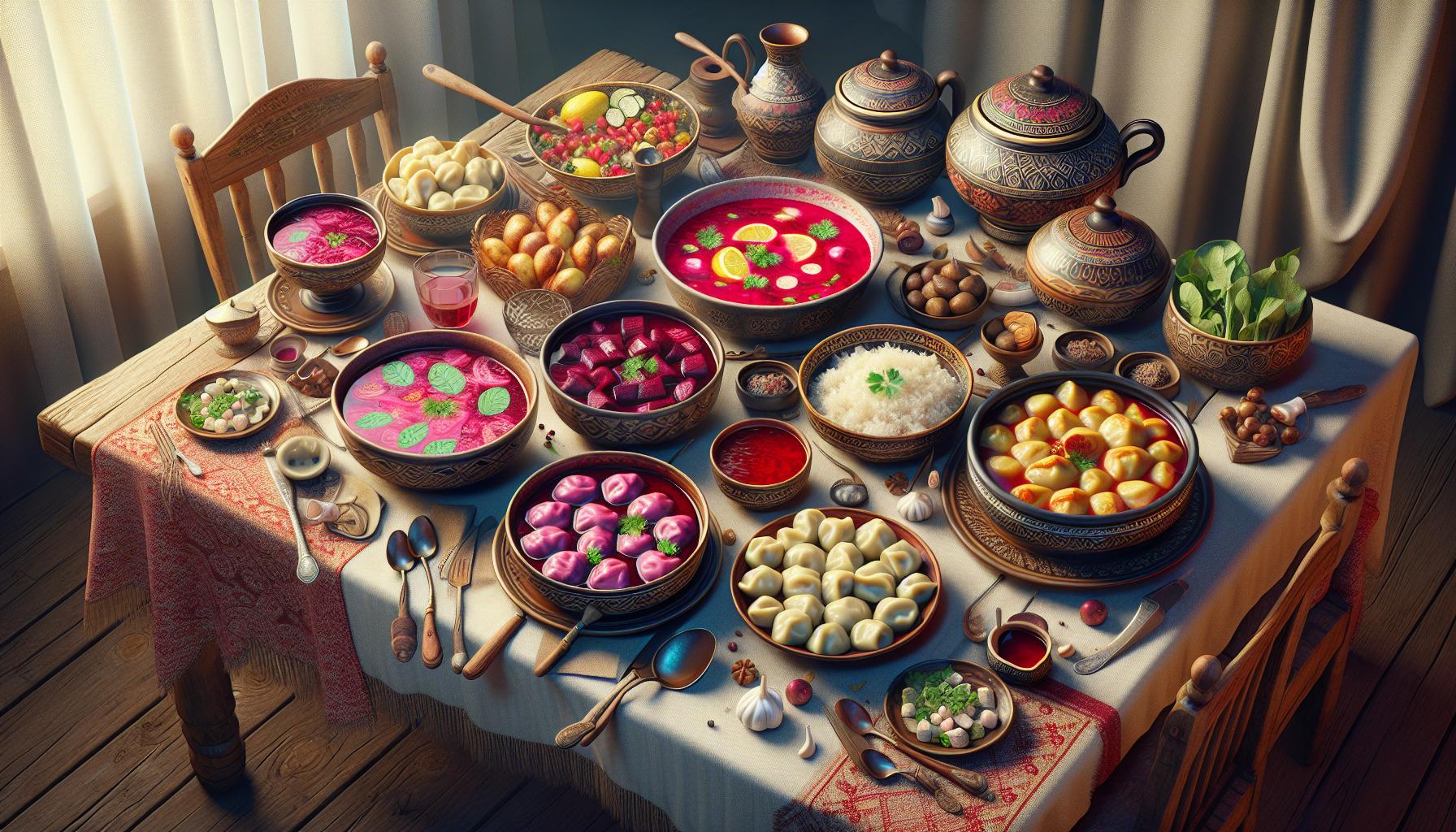The Best Fluffy Pancakes recipe you will fall in love with. Full of tips and tricks to help you make the best pancakes.
Russian cuisine tells a fascinating story of survival resilience and celebration spanning centuries of rich cultural heritage. From hearty borscht to delicate beef stroganoff the diverse flavors of Russian food reflect the nation’s vast geography and challenging climate.
Beyond the stereotypical images of vodka and caviar Russian food culture embraces warm hospitality and cherished traditions. Meals aren’t just about sustenance – they’re social events where families gather around steaming samovars sharing stories over plates of pelmeni dumplings and fragrant black bread. The Russian table transforms into a place where centuries-old recipes meet modern interpretations creating an experience that’s both comforting and adventurous.
Traditional Russian Food Values and Customs
Russian food culture centers around communal dining experiences with strong symbolic meanings. Traditional customs emphasize hospitality generous portions hospitality shared meals.
The Role of Bread in Russian Culture
Bread holds sacred status in Russian culture as a symbol of life prosperity respect. Black rye bread (cherny khleb) appears at every Russian meal accompanied by salt for welcoming guests. Ancient customs dictate presenting decorated loaves at milestone celebrations like weddings births funerals. Russian households preserve specific rituals for handling bread including never placing a loaf upside down storing it in designated cloths. Traditional bread varieties like karavai feature intricate braided designs decorated with dough flowers birds signifying good fortune. Modern Russian bakeries continue centuries-old sourdough techniques passed through generations.
Family Dining Traditions
Russian families gather for extended multi-course meals that last 2-3 hours minimum. The traditional setup includes zakuski (appetizers) displayed family-style across the table with the samovar centerpiece. Parents teach children to finish everything on their plates reflecting historical food scarcity respect for provisions. Conversations flow freely as family members take turns serving dishes sharing daily experiences. Meal timing follows a structured pattern: breakfast (zavtrak) at 8 AM lunch (obed) at 2 PM dinner (uzhin) at 7 PM. Sunday lunches bring extended family together featuring special dishes like homemade pelmeni kotlety prepared collaboratively.
Essential Dishes in Russian Cuisine

Russian cuisine features hearty dishes developed over centuries to combat cold climates and celebrate cultural traditions. Traditional recipes emphasize filling ingredients like potatoes, mushrooms, fish, and various meats.
Soups and Stews
Borscht stands as Russia’s signature soup, combining beets, cabbage, potatoes, and meat in a rich broth. Shchi represents another cornerstone of Russian soup culture, made with fresh cabbage, carrots, onions, and meat stock. Ukha offers a clear fish soup traditionally prepared with freshwater fish varieties like pike, perch, or sturgeon. Solyanka delivers a hearty combination of various meats, pickled cucumbers, olives in a sour-salty broth. These soups commonly include a dollop of smetana (sour cream) for serving.
Main Course Staples
Beef Stroganoff features tender strips of beef in a creamy mushroom sauce served over egg noodles. Pelmeni consists of meat-filled dumplings, similar to ravioli, topped with butter, sour cream, or vinegar. Kotlety presents ground meat patties served with mashed potatoes or buckwheat kasha. Traditional side dishes include olivier salad, vinegret (beet salad), and golubtsy (stuffed cabbage rolls) accompanied by black rye bread.
Traditional Holiday Foods
Kholodets emerges during celebrations as a savory meat jelly made from long-simmered beef or pork. Easter brings kulich (sweet bread) paired with paskha (pyramid-shaped cheese dessert). New Year celebrations feature olivier salad, red caviar on buttered bread, and zakuski (appetizer spreads). Christmas dishes include kutya (grain pudding) served with vzvar (dried fruit compote). Special occasions showcase elaborate pirogi filled with sweet or savory ingredients like potato, cabbage, or fruit.
Historical Influences on Russian Food
Russian cuisine evolved through centuries of cultural exchanges geographic expansion. The history spans from ancient Slavic traditions to modern interpretations shaped by political changes social movements.
Soviet Era Impact
The Soviet era transformed Russian food culture through standardization collectivization from 1917 to 1991. State-run cafeterias called “stolovayas” introduced uniform dishes across the USSR creating a shared culinary experience. The Soviet government published “The Book of Tasty and Healthy Food” in 1939 which standardized recipes influenced home cooking practices. Popular dishes from this period include:
- Salat Olivier: A potato-based salad created in the 1860s modified during Soviet times
- Kotlety: Mass-produced meat patties served in schools workplaces
- Syrniki: Cheese pancakes that became a common breakfast item
- Kompot: Fruit drink made from preserved fruits available year-round
Regional Variations
Russian cuisine encompasses distinct regional specialties influenced by local ingredients climatic conditions. Northern regions feature:
- Fish dishes: Smoked omul from Lake Baikal
- Wild game: Elk venison prepared in traditional ways
- Forest ingredients: Mushrooms berries preserved for winter
- Caucasian influences: Shashlik marinaded meats
- Central Asian elements: Plov rice dishes
- Black Sea specialties: Fresh seafood caviar
| Region | Signature Ingredients | Notable Dishes |
|---|---|---|
| Siberia | Cedar nuts wild game | Pelmeni stroganina |
| Volga | River fish grains | Ukha rassolnik |
| Ural | Root vegetables | Posikunchinki shangi |
| Far East | Pacific seafood | Pyanse krab |
Modern Russian Food Culture
Russia’s contemporary food culture blends traditional customs with global influences, creating a dynamic culinary landscape that reflects both heritage and innovation.
Restaurant Scene Evolution
Moscow’s restaurant scene transformed significantly after 1991, featuring diverse international cuisines alongside reinvented Russian classics. High-end establishments serve modern interpretations of traditional dishes, such as elevated versions of borscht paired with molecular gastronomy techniques. Street food markets like Danilovsky in Moscow showcase local specialties next to global offerings. International franchises operate alongside traditional Russian cafes, creating a vibrant mix of dining options. Contemporary Russian chefs incorporate local ingredients into fusion dishes, combining traditional cooking methods with modern presentations. Fine dining restaurants in major cities earned recognition in international restaurant guides, with several establishments receiving Michelin stars in 2021.
Home Cooking Today
Russian families maintain traditional cooking practices while embracing contemporary ingredients and techniques. Weekly meal preparation includes both classic dishes like kotlety and modern interpretations using appliances like multicookers and air fryers. Social media platforms influence home cooking trends, inspiring cooks to share recipe adaptations of traditional favorites. Urban households incorporate international ingredients into Russian recipes, creating fusion versions of classic dishes. Home cooks prioritize fresh seasonal produce from local markets, maintaining the connection to traditional ingredient sourcing. Meal delivery services offer convenience while preserving authentic flavors through partnerships with local producers. Family gatherings continue to center around home-cooked meals, combining traditional recipes with modern dietary preferences.
Russian Drink and Beverage Traditions
Russian beverage culture centers around social gatherings where drinks serve as catalysts for connection and celebration. The drinking traditions in Russia reflect centuries of cultural evolution, combining ancient customs with modern practices.
Tea Culture
Tea holds a central position in Russian daily life, with Russians consuming an average of 3-5 cups per day. The traditional Russian tea ceremony involves brewing concentrated tea in a samovar, a decorative metal urn that keeps water hot for hours. Black tea dominates Russian preferences, accompanied by sugar cubes, lemon slices, honey or jam. Russians serve tea in glass holders called podstakanniki, featuring ornate metal designs. Traditional tea accompaniments include sushki (small, crunchy bread rings), pryaniki (spiced cookies) and various sweet pastries. Tea gatherings called chaepitie represent informal social occasions where friends gather for hours of conversation.
Traditional Alcoholic Drinks
Vodka stands as Russia’s signature spirit, dating back to the 14th century. Russians traditionally serve vodka neat at room temperature in 50ml portions alongside zakuski (appetizers). Medovukha, a fermented honey beverage, traces its origins to ancient Slavic traditions with 5-16% alcohol content. Popular grain-based drinks include kvass, a fermented beverage made from rye bread with less than 1% alcohol. Russian wineries in regions like Krasnodar produce local wines, while sbiten, a hot winter drink, combines honey with spices and herbs. Contemporary craft beer culture thrives in major cities, featuring local breweries producing traditional Russian styles alongside modern interpretations.
Social Aspects of Russian Dining
Russian dining culture emphasizes communal experiences that strengthen social bonds through shared meals. The act of dining together serves as a cornerstone of Russian social life, fostering deep connections among family members and friends.
Hospitality and Guest Etiquette
Russian hosts demonstrate hospitality by serving abundant food and ensuring guests’ plates remain full throughout the meal. Guests receive the best dishes, seats, and utensils in the house. Traditional etiquette dictates removing shoes upon entering a home, bringing a small gift like chocolates or flowers, and waiting for the host’s invitation to begin eating. Declining food or drink three times signals genuine refusal, while initial declinations are met with persistent encouragement. Leaving food on the plate indicates satisfaction with the meal, though emptying the plate compliments the cook. Toasting practices follow a structured order, with the host initiating the first toast, followed by honored guests.
Celebratory Feasts
Russian celebrations center around elaborate feasts featuring multiple courses served over 4-5 hours. New Year’s celebrations include olivier salad, caviar on black bread, and champagne at midnight. Easter feasts showcase kulich (sweet bread) paskha (cottage cheese dessert) colored eggs. Wedding celebrations feature specific dishes like karavay (ceremonial bread) decorated with salt. Birthday gatherings include traditional tortes pirog (savory pies) zakuski (appetizers). Each celebration incorporates distinct rituals, such as breaking bread together at weddings or sharing blini during Maslenitsa. Guests contribute dishes to these gatherings, creating a collaborative feast that strengthens community bonds.
Conclusion
Russian food culture stands as a testament to the nation’s endurance adaptability and deep-rooted traditions. From hearty soups that warm winter evenings to elaborate feasts that mark life’s celebrations this cuisine reflects centuries of history and social evolution.
Today’s Russian dining scene masterfully blends time-honored customs with contemporary influences. Whether it’s a family gathering over home-cooked meals or a modern restaurant’s creative take on classic dishes Russian food culture continues to evolve while maintaining its core values of hospitality community and celebration.
The traditions that have shaped Russian cuisine for generations remain alive in kitchens across the country proving that food is more than sustenance – it’s a bridge between past and present a symbol of resilience and an expression of love.

